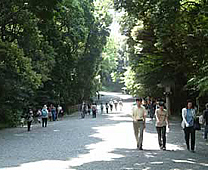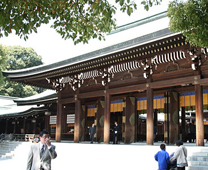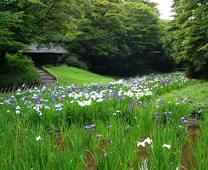
Travel Guide
Introduction
Meiji Shrine is a Shinto shrine dedicated to the deified spirits of Emperor Meiji and his consort, Empress Shoken. The two revered members of the royal family are entombed in Kyoto but the Meiji Shrine was erected so that people in Tokyo could pay their respects to the couple. Located just beside the JR Yamanote Line's busy Harajuku Station, Meiji Shrine and the adjacent Yoyogi Park make up a large forested area within the densely built-up city. The spacious shrine grounds offer walking paths that are great for a relaxing stroll.
Meiji Shrine is one of the Japan's most popular shrines. In the first days of the New Year, the shrine regularly welcomes more than three million visitors for the year's first prayers (hatsumode), more than any other shrine or temple in the country. During the rest of the year, traditional Shinto weddings can often be seen taking place there.
As Meiji Shrine is an active Shinto shrine it is possible to see Shinto wedding parties parading through the inner ground of the shrine. This is an amazing sight to see with the bride in the traditional Japanese wedding kimono (Uchikake), shrine maidens, Shinto priests and the wedding party with the women wearing gorgeous kimono
Shrine complex
The shrine itself is composed of two major areas:
Naien
The Naien is the inner precinct, which is centered on the shrine buildings and treasure house.
Shrine buildings are located in a forest that covers an area of 700,000 square-meters (about 175 acres). This area is covered by an evergreen forest that consists of 120,000 trees of 365 different species, which were donated by people from all parts of Japan when the shrine was established. The forest is visited by many as a recreation and relaxation area in the center of Tokyo.
Entry into the grounds is marked by massive torii gate in Japan, after which the sights and sounds of the busy city are replaced by a tranquil forest. You will also feel the air of tranquility that resides within the area. Walking along the wide, lengthy path to the shrine is an enjoyable experience in itself as it offers two things you cannot usually find in Tokyo: Precious silence and open space.
At the middle of the forest, Meiji Shrine's buildings also have an air of tranquility distinct from the surrounding city. Visitors to the shrine can take part in typical Shinto activities, such as making offerings at the main hall, buying charms and amulets or writing out one's wish on an ema.
Treassure house, Meiji Jingu Treasure House, was constructed one year after the shrine was opened. The Treasure House displays many interesting personal belongings of the Emperor and Empress, including the carriage which the emperor rode to the formal declaration of the Meiji Constitution in 1889. The treasure museum is built in the Azekurazukuri style. There is also a Museum Annex Building just to the east of the main shrine buildings that displays temporary exhibitions.
A large area of the southern section of the shrine grounds is taken up by the Gyoen Garden, which requires an entrance fee to enter. The garden becomes particularly popular during the middle of June when the irises are in bloom. It is said the Emperor Meiji designed the Iris Garden himself for the pleasure of his wife. A small well located within the garden, Kiyomasa's Well, is named after a military commander who dug it around 400 years ago. The well was visited by the Emperor and Empress while they were alive and has become a popular spiritual "power spot".
Gaien
The Gaien is the outer precinct, which includes the Meiji Memorial Picture Gallery that houses a collection of 80 large murals illustrative of the events in the lives of the Emperor and his consort. It also includes a variety of sports facilities, including the National Stadium (Meiji Jingu Gaien Stadium and later, since 1956, on the same site Tokyo Olympic Stadium), the Meiji Memorial Hall, which was originally used for governmental meetings, including discussions surrounding the drafting of the Meiji Constitution in the late 19th century. Today it is used for Shinto weddings.
History
After the emperor's death in 1912, the Japanese Diet passed a resolution to commemorate his role in the Meiji Restoration. An iris garden in an area of Tokyo where Emperor Meiji and Empress Shoken had been known to visit was chosen as the building's location.
Construction began in 1915 under Ito Chuta, and the shrine was built in the traditional nagare-zukuri style and is made up primarily of Japanese cypress and copper. It was formally dedicated in 1920, completed in 1921, and its grounds officially finished by 1926. Until 1946, the Meiji Shrine was officially designated one of the Kanpei-taisha, meaning that it stood in the first rank of government supported shrines.
The original building was destroyed during the Tokyo air raids of World War II. The present iteration of the shrine was funded through a public fund raising effort and completed in October, 1958.
 |
 |
 |
| Pathway to shrine | Hondo (main hall) | Iris Garden |
Travel Advice
Sightseeing
- Meiji Shrine Forest makes you imagine of an ancient forest which contains the perfect ecocycle of plants and animals, yet it was designed and created by human beings in the span of only 90 years. If you are lucky, you can see small animals like rabbit, snake or raccoon dog playing or hunting for food.
- The Torii for the Meiji Shrine is made from 1,500-year-old cypress trees from Mt. Tendai of Taiwan. It is a myojin style, adorned with the imperial logo (chrysanthemum). This particular torii happens to be the o-torii, the largest wooden myojin gate in Japan. It's dimensions are: height (12 m), diameter of each pillar (1.2 m), crossbeam (17 m), lower crossbeam (15.5 m), distance between pillars (9.1 m).
- It is said that people can be purified by little white stones, so the pathway to the main hall is covered with little white stones. People is purified with white stones while walking toward the sacred places.
- Omikuji are pre written random fortunes written on strips of paper at Shinto shrines and Buddhist temples in Japan. A small coin offering is made to the Shrine or Temple and then the omikuji are randomly chosen from a box, hoping for the fortune to be good. Different from the omikuji in other Shinto shrines and Buddhist temples in Japan, Meiji Shrine has chosen 15 Waka each from the works of Emperor Meiji and Empress Shoken, the Waka which can be the morality guidance to the people. 20 of the Waka Omikuji are available in English.
Emperor Meiji
Emperor Meiji was the first emperor of modern Japan. He was born in 1852 and ascended to the throne in 1867 at the peak of the Meiji Restoration when Japan's feudal era came to an end and the emperor was restored to power. During the Meiji Period, Japan modernized and westernized herself to join the world's major powers by the time Emperor Meiji passed away in 1912.
Visit
| Address | 1-1 Yoyogi-kamizono-cho, Shibuya-ku, Tokyo | |
| Phone | 03-3379-5511 (shrine office) | |
| Admission | Free | |
| Hours | Free time | |
| Closed | Open 7 Days a Week | |
| Duration | 30 minutes | |
| Getting There | By Train 1 minute walk from Harajuku Station on JR Yamanote Line. 5 minutes walk from Yoyogi Station on JR Yamanote Line. 3 minutes walk from Sangubashi Station on Odakyu Line. 1 minute walk from Meiji-jingu Station on subway Chiyoda Line. 1 minute walk from Meiji-jingu Station on subway Fuku-toshin Line. 5 minutes walk from Yoyogi Station on subway Oedo Line. 5 minutes walk from Kita-sando Station on subway Oedo Line. By Car Take Route 4 (Shinjuku Route) of Shuto Expressway to the Yoyogi exit or Harajuku exit. It is approximately 5 minutes from exit. |
|
| Parking | Paid parking available | |

